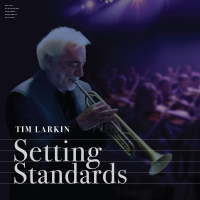Home » Jazz Articles » Multiple Reviews » Satoko Fujii: Bell The Cat!, Illusion Suite, Minerva, Ze...
Satoko Fujii: Bell The Cat!, Illusion Suite, Minerva, Zephyros, and Angelona
Fujii's trio plays avant-garde jazz that uses Eastern European or Balkan scales, and complex meters. Bassist Mark Dresser plays a notable role in shaping and propelling the trio's performance. In the quartet, rock-influenced grooves and assertive sound are shaped and informed by drummer Tatsuya Yoshida, as well as trumpeter and composer Natsuki Tamura, who's also Fujii's husband.
Structurally, many Fujii compositions follow the mainstream jazz form: head melody, solos and reprise of the head, sometimes expanded with an introduction and interludes. Other Fujii compositions have a freer overall form, based on a thematic sound or motif that is developed into segments or episodes.
Fujii's performances make frequent use of the motif, usually melodic but sometimes rhythmic, as repeating pattern, bass line or starting point for improvisation. A notable motif in Fujii's work is the half-step (minor second), especially in its descending form. The half-step is closely associated with the Phrygian scale, which is found throughout her compositions. Many of Fujii's works also use pentatonic (five-note) scales, characteristic of many Asian and European musics.
Fujii's descriptive abilities vividly convey images and narratives. She makes telling use of varied and atypical sounds, both acoustic and electronic, from her own and group members' instruments.
 Satoko Fujii
Satoko Fujii
Bell The Cat!
Tokuma Japan Communications
2002
Bell the Cat! is charmingly descriptive, evoking feline mystery, playfulness, and sudden change. "Silence opens mysteriously with Fujii's abstract chords over Dresser's spare line and Black's lightly rattling and meowing rubbed-cymbal sounds. During his free-form solo, Dresser bows soft harmonics and creates a high-pitched plucking sounding like a Japanese koto. The trio explodes into chaos, and Fujii alternates montuno patterns with free playing while the other two players flail. The mood calms as Fujii plays a bell-like pattern in parallel octaves.
"Get Along Well With... swings with a little funk. Fujii plays the head, sing-song with a shifting tonal center, and goes into open-ended improvisation in parallel tenths, contrary motion and triadic chords. Toward the end, the trio furiously cycles through a pattern, playing wildly, pounding, like cats (or children) delightedly running in circles.
"Slowly and Slowly builds in volume and tension throughout. Fujii and Dresser play the deliberate, low-pitched, minor, step-wise melody, harmonized in octaves and tenths. Black creates a ratchety sound like a cat's purr. Fujii's polyphonic lines suggest a Bach fugue. A more aggressive groove emerges, and Fujii adds Spanish-style ornamentation in the style of Chick Corea. By closing phrases with a diminished chord, she builds harmonic tension as the line rises chromatically.
The restless "Confluence opens with Fujii's rambling melody, accompanied by jingling bells. Dresser's spare, bent, plucked notes suggest meows and skittering around, which grow insistent while Fujii plays an atonal melody in octaves and then a repeated syncopated pattern on a descending minor third. Dresser takes a squeaky arco solo, enhanced by bells and rattles. Fujii plays low-range octaves and builds a montuno drive with a 3-2 clave. After a bass and drums duo solo, Fujii and Dresser reprise the head tune. Fujii trails off with a minor-scale treble line, in an unexpectedly serious mood.
"Foot Step centers on Fujii's continual rising half-step motif, suggesting the tread of a cat. In "Bell the Cat!, the cat creeps with short, low phrases on piano and then bass, while drums plays noisily. After Fujii's montuno-style solo, Black and Dresser engage in subtle interplay over Fujii's continuous tremolo. The comical "Champloo opens with weird, rattly prepared piano and percussion resembling tin cans. Fujii and Dresser play a tune in diatonic and major pentatonic, like a European folk song with a North African flavor. At the end, the tempo increases and the trio dissolve into a feline frenzy.
 Satoko Fujii Trio
Satoko Fujii Trio
Illusion Suite
Libra Records
2004
Illusion Suite makes clearly evident the exquisite rapport among the trio members. "Illusion Suite evokes the classical definition of suite: a sequence of musical segments that vary in tempo and/or rhythm. Yet the three players maintain momentum as they weave complementary parts. Dresser bows the melody, which starts with a falling minor third and includes the familiar falling half-step, backed by impressionistic piano chords and rubbed cymbals. Fujii improvises with parallel chords and splatty clusters in a samba-like groove.
Later, she plays a Phrygian scale variant melody over parallel triads moving modally and embellished with glissandos. Black's marchlike snare figure punctuates a funky groove, and then the trio bursts into chaos, with drums full-force and Fujii's whirlwind keyboard work alternating with strummed strings. Fujii falls into a hymnlike cycle of triadic chords, as though on a quest. Toward the end, Dresser bows an unaccompanied cadenza-like solo.
The free-form "An Irregular Course starts softly with Dresser's descending lines of scraping and plucking. Black plays shakes and strikes percussive instruments, and Fujii plucks strings and plays dreamy cluster chords. Her line slides around chromatically, in repeating figures harmonized in parallel thirds. The chromatic figures grow louder and faster, and then they die away.
"Flying To The South is borne aloft by a seemingly irresistible force. Fujii's introduction grows from repeated notes in free rhythm into melodic phrases. Black's drums raise the volume, and with Dresser doubling on the bass part, Fujii plays the Phrygian melody with odd phrases in a complex meter. The effect is a European folk dance with a touch of American hoedown, played up by Dresser's hard-bowed solo with double stops, sounding like a low-pitched folk fiddle. Black's Brazilian-tinged percussion conveys the southward movement, and Fujii returns to montuno. While Black finishes his solo, Fujii and Dresser reprise their punchy, falling half-step vamp.
"An Insane Scheme centers on colorful sounds, some electronically produced and others of uncertain origin. Fujii and Dresser play the 3/4 time melody, which includes a falling half-step, with a background of mysterious percussive noises and witchy cackling and groaning. Dresser bows hard on the first beat of each measure and ends it with a squeal. Alternately with improvising on the melody, Fujii plays flailing clusters and twittering runs in 4/4 time. The three players take short free-form solos, interspersed with various rhythmic and motivic patterns, and at the end the mysterious noises return.  Satoko Fujii Quartet
Satoko Fujii Quartet
Minerva
Libra Records
2002
Minerva evokes the ancient Roman tale of Arachne, a young weaver who dared to challenge Minerva, the goddess of weaving, with a stunning tapestry of the gods. In a jealous rage, Minerva turned the hapless Arachne into a spider.
Tamura sets the mood of dramatic confrontation with his composition "Tatsu Take. He plays a thematic salvo of syncopated, single-note jabs, each quickly echoed by a rhythm-section hit on a dissonant pitch, followed by a chromatically descending, irregularly phrased line. Fujii plays a free, single-line solo with chromatic runs.
Fujii's high-tension "Warp opens with electronically-processed sounds that include distorted ghostly voices and ringing strings. Tamura plays a reverberating free-form line and then a fast, repeating phrase. Eventually, bassist Takeharu Hayakawa and drummer Tatsuya Yoshida play the thematic melody built on a deliberate, four-note, two-measure pattern with a blues flavor. Toward the end, Fujii plays a fast, Latinish repeating bass figure that's picked up by Hayakawa.
"Selvedge opens slowly with Fujii's impressionistic high-pitched chords, alternating modally. Hayakawa plays squeaky harmonics, and Tamura makes odd noises with his mouthpiece. Hayakawa plucks slowly, and Tamura bellows and twitters. Toward the end, they all go into frenetic improvisation, finishing abruptly in a pulsating buzz.
"Weft starts with Fujii's long, dense-textured introduction, tritone-centered patterns and blues-tinged romanticism, recalling Gershwin's "Preludes. Tamura plays the slow, irregularly-phrased and tonally uncentered melody that starts with a falling minor second, while Fujii and Hayakawa play contrary-motion counterpoint. The groove shifts radically to an up-tempo flamenco, and Tamura plays a tune with simple, major-scale phrases and a shifting tonal center.
"Caught In A Web is a free-form, high-tension drama. Fujii plucks the piano strings lightly, suggesting a spider working in its web. Rattling and high-pitched spronging evoke a fly ensnared. Rude buzzing is joined by staccato plucked bass, light rattly drumming, and tinkling piano. Tamura plays a jaunty cabaret-like tune reminiscent of Stravinsky's "Soldier's Tale. Fujii plays atonal high-pitched tinkling with a few clusters, suggesting a dizzy and panicked fly struggling to escape.
With reverberating chords, dominated by trumpet and rolled cymbal, the web becomes a tunnel of doom. Fujii takes a solo in loud splats, which Tamura joins with fast nervous runs and tremolos: the fly tries to escape. Everything slows down, and the echo chamber sound returns with double-time octaves in piano and trumpet. After a moment of wildly distorted bass (the fly's last buzz?), they accelerate into a fast riff and end.
 Satoko Fujii Quartet
Satoko Fujii Quartet
Zephyros
NatSat
2003
In ancient Greece, Zephyros was god of the west wind. Fittingly, Zephyros is driven by fast tempos and danceable grooves. The rock influence of Hayakawa and drummer Tatsuya Yoshida is more pronounced than on Minerva, contributing to a more forceful sound.
After Yoshida and Hayakawa's vigorous introduction to "The Future Of The Past, Fujii plays the melody in high, dissonant chords over low tremolos. Later, Hayakawa and Yoshida introduce a Middle Eastern sounding groove, and Tamura plays a harmonic-minor melody in which slinky chromatic movement ends in an upward leap. Fujii starts "As Usual with a slow, six-note repeating figure in two-part dissonant harmony. Tamura plays the dreamy melody, which Hayakawa doubles. The volume grows, and they break to a fast, tense, loud tune in a Latin groove.
Compared with the version on Illusion Suite, this "Flying To The South is more relaxed, with shorter solos. Here, Fujii tends to lead, and Tamura frequently supports Fujii's melody line. Hayakawa stands out in a rock-style solo. He then introduces "First Tango, sliding upward with melismatic ornamentation. Fujii and Tamura play the tango tune, irregularly phrased with chromaticism and parallel thirteenths. Fujii takes a bass-accompanied, modal solo, in parallel octaves and then in dissonant chords which are increasingly loud, high and fast.
In "Clear Sky For Christopher, Tamura plays the up-tempo major-mode head, backed by an amusing "oompah that conjures a cabaret or sophisticated circus. The tricky meter includes measures of five, six, and seven beats. Fujii plays a melodic solo with runs, grace notes, and parallel thirds. "One Summer Day starts with trumpet and bass on a sustained-tone introduction that recalls the work of Kenny Wheeler. Fujii and Yoshida join in with a repeating pattern accompaniment in slightly agitated up-tempo melody, which seems to rise chromatically. Fujii solos in a single line over a Brazilian sounding left hand. The tempo slows while Fujii plays busy patterns, and Tamura rejoins in a long-note tune with some chromatic slides.
"15 Minutes To Get To The Station bursts with distorted voices, "raspberries, and other weird sounds. Tamura's trumpet warbles, squawks, squeaks, and bellows like an elephant. Later, Fujii plays a pattern in parallel octaves, and then she is left alone to play a slow, dissonantly harmonized pattern of three descending notes that recall "Three Blind Mice. After Hayakawa's solo, the spooky vocal effects return lightly in the background. At the end, Tamura improvises on the three-note motif.
 Satoko Fujii Quartet
Satoko Fujii Quartet
Angelona
Libra Records
2005
Angelona alludes to the goddess Angerona, who for the ancient Greeks embodied secrecy and the winter solstice. Compared with Minerva and Zephyros, this music tends to longer and more complex forms and more subtle dynamics. It also shows the influence of the Eastern European scales and rhythms more characteristic of Fujii's trio.
On the free-form, atonal melody of "An Alligator In Your Wallet, Fujii improvises using parallel chords, clusters and runs in the jazz-rock groove. Tamura's unaccompanied solo sounds like a laid-back paraphrase of the cadenza on "A Night In Tunisia" which saxophonist Charlie Parker and trumpeter Dizzy Gillespie each immortalised in the mid 1940s. Fujii introduces "Collage In The Night with a pop-flavored phrase, harmonized with a touch of blues in the minor against major third degree. Over a gentle tango-like beat, she expands the phrase into an unexpectedly complex melody. In an interesting episode, Hayakawa plays expressive bent tones, suggesting whale song.
"A Poor Sailor is a rollicking tune, recalling Bell The Cat!, with an intricate form. Parts A and C are phrases of brisk East European folk music in 10/4 meter. Part B is four measures of 4/4 down-and-dirty blues. Fujii plays A, the entire quartet plays all three parts, and Fujii and Tamura each improvise on A, B, and C.
The jazz-rock "A Journey Into The West is a good vehicle for Tamura, who solos while Fujii comps with jabbing chords and counter-rhythmic upward runs. Hayakawa's outstanding unaccompanied solo journeys from an Asian-sounding parallel-fifths section into a distortion-laced rock sound, and then vacillates between Eastern and Western styles.
The evocative "Cicada starts with continuous buzzing and rattling, fast strumming of piano strings, and light squawks and wails on trumpet. The thrum increases, and a triplet-based repeating figure emerges, over which Tamura plays an even-note, ascending tune. The groove changes to jazz-rock, and Tamura plays a one-pitch, two-note motif on different pitches and beats. Later, Fujii, Yoshida and Hayakawa play the two-note motif as a triplet on a falling half-step. Hayakawa's solo starts with improvisation on the falling half-step motif, harmonized in parallel fifths and fourths.
In the extended introduction to "A Brick House, Hayakawa improvises conversationally with an irregular octave drone, Phrygian scale, blue notes, and chromatic shifting. Yoshida and Fujii join in unison to create a rock-like feel with an irregularly-phrased, even-note Phrygian and melodic-minor line. Tamura takes over to play a long unaccompanied, freely improvised, melismatic line. Eventually, Tamura plays the even-note melody, on which all improvise.
Tracks and Personnel
Bell The Cat!
Tracks: Silence; Get Along Well with...; Slowly And Slowly; Confluence; Foot Step; Bell The Cat!; Champloo.
Personnel: Satoko Fujii: piano; Mark Dresser: bass; Jim Black: drums.
Illusion Suite
Tracks: Illusion Suite; An Irregular Course; Flying To The South; An Insane Scheme.
Personnel: Satoko Fujii: piano; Mark Dresser: bass; Jim Black: drums.
Minerva
Tracks: Tatsu Take; Warp; Selvedge; Weft; Caught In A Web.
Personnel: Satoko Fujii: piano; Natsuki Tamura: trumpet; Takeharu Hayakawa: bass; Tatsuya Yoshida: drums, voice.
Zephyros
Tracks: The Future Of The Past; As Usual; Flying To The South; First Tango; One Summer Day; Clear Sky" For Christopher; 15 Minutes To Get To The Station.
Personnel: Satoko Fujii: piano; Natsuki Tamura: trumpet; Takeharu Hayakawa: bass; Tatsuya Yoshida: drums, voice.
Angelona
Tracks: An Alligator In Your Wallet; Collage In The Night; A Poor Sailor; A Journey Into The West; Cicada; A Brick House.
Personnel: Satoko Fujii: piano; Natsuki Tamura: trumpet; Takeharu Hayakawa: bass; Tatsuya Yoshida: drums.
Tags
PREVIOUS / NEXT
Support All About Jazz
 All About Jazz has been a pillar of jazz since 1995, championing it as an art form and, more importantly, supporting the musicians who make it. Our enduring commitment has made "AAJ" one of the most culturally important websites of its kind, read by hundreds of thousands of fans, musicians and industry figures every month.
All About Jazz has been a pillar of jazz since 1995, championing it as an art form and, more importantly, supporting the musicians who make it. Our enduring commitment has made "AAJ" one of the most culturally important websites of its kind, read by hundreds of thousands of fans, musicians and industry figures every month.























